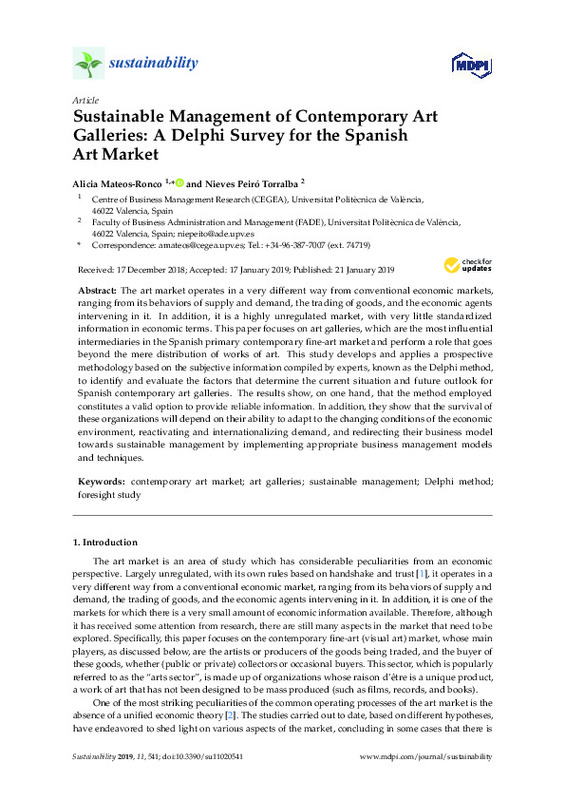Baumol, W. J. (1985). Unnatural Value: Or Art Investment as Floating Crap Game. Journal of Arts Management and Law, 15(3), 47-60. doi:10.1080/07335113.1985.9942162
Ginsburgh, V., & Jeanfils, P. (1995). Long-term comovements in international markets for paintings. European Economic Review, 39(3-4), 538-548. doi:10.1016/0014-2921(94)00060-d
Chanel, O. (1995). Is art market behaviour predictable? European Economic Review, 39(3-4), 519-527. doi:10.1016/0014-2921(94)00058-8
[+]
Baumol, W. J. (1985). Unnatural Value: Or Art Investment as Floating Crap Game. Journal of Arts Management and Law, 15(3), 47-60. doi:10.1080/07335113.1985.9942162
Ginsburgh, V., & Jeanfils, P. (1995). Long-term comovements in international markets for paintings. European Economic Review, 39(3-4), 538-548. doi:10.1016/0014-2921(94)00060-d
Chanel, O. (1995). Is art market behaviour predictable? European Economic Review, 39(3-4), 519-527. doi:10.1016/0014-2921(94)00058-8
Gérard-Varet, L.-A. (1995). On pricing the priceless: Comments on the economics of the visual art market. European Economic Review, 39(3-4), 509-518. doi:10.1016/0014-2921(94)00057-7
Holub, H. W., Hutter, M., & Tappeiner, G. (1993). Light and shadow in art price computation. Journal of Cultural Economics, 17(1), 49-69. doi:10.1007/bf00820767
Beckert, J., & Rössel, J. (2013). THE PRICE OF ART. European Societies, 15(2), 178-195. doi:10.1080/14616696.2013.767923
Schönfeld, S., & Reinstaller, A. (2007). The effects of gallery and artist reputation on prices in the primary market for art: a note. Journal of Cultural Economics, 31(2), 143-153. doi:10.1007/s10824-007-9031-1
Abdullah, A., Khadaroo, I., & Napier, C. J. (2018). Managing the performance of arts organisations: Pursuing heterogeneous objectives in an era of austerity. The British Accounting Review, 50(2), 174-184. doi:10.1016/j.bar.2017.10.001
Komarova, N., & Velthuis, O. (2017). Local contexts as activation mechanisms of market development: contemporary art in emerging markets. Consumption Markets & Culture, 21(1), 1-21. doi:10.1080/10253866.2017.1284065
Landeta, J., Matey, J., Ruíz, V., & Galter, J. (2008). Results of a Delphi survey in drawing up the input–output tables for Catalonia. Technological Forecasting and Social Change, 75(1), 32-56. doi:10.1016/j.techfore.2007.01.005
Hayes, T. (2007). Delphi study of the future of marketing of higher education. Journal of Business Research, 60(9), 927-931. doi:10.1016/j.jbusres.2006.12.009
Okoli, C., & Pawlowski, S. D. (2004). The Delphi method as a research tool: an example, design considerations and applications. Information & Management, 42(1), 15-29. doi:10.1016/j.im.2003.11.002
Maguire, J. S., & Matthews, J. (2012). Are we all cultural intermediaries now? An introduction to cultural intermediaries in context. European Journal of Cultural Studies, 15(5), 551-562. doi:10.1177/1367549412445762
JOY*, A., & SHERRY, JR.‡, J. F. (2003). Disentangling the paradoxical alliances between art market and art world. Consumption Markets & Culture, 6(3), 155-181. doi:10.1080/1025386032000153759
Mateos-Ronco, A., & Server Izquierdo, R. J. (2011). Drawing up the official adjustment rules for damage assessment in agricultural insurance: Results of a Delphi survey for fruit crops in Spain. Technological Forecasting and Social Change, 78(9), 1542-1556. doi:10.1016/j.techfore.2011.04.003
Webler, T., Levine, D., Rakel, H., & Renn, O. (1991). A novel approach to reducing uncertainty: The group Delphi. Technological Forecasting and Social Change, 39(3), 253-263. doi:10.1016/0040-1625(91)90040-m
STRAUSS, H. J., & ZEIGLER, L. H. (1975). The Delphi Technique and Its Uses In Social Science Research*. The Journal of Creative Behavior, 9(4), 253-259. doi:10.1002/j.2162-6057.1975.tb00574.x
Rowe, G., Wright, G., & Bolger, F. (1991). Delphi: A reevaluation of research and theory. Technological Forecasting and Social Change, 39(3), 235-251. doi:10.1016/0040-1625(91)90039-i
Woudenberg, F. (1991). An evaluation of Delphi. Technological Forecasting and Social Change, 40(2), 131-150. doi:10.1016/0040-1625(91)90002-w
Turoff, M. (1970). The design of a policy Delphi. Technological Forecasting and Social Change, 2(2), 149-171. doi:10.1016/0040-1625(70)90161-7
Landeta, J., Barrutia, J., & Lertxundi, A. (2011). Hybrid Delphi: A methodology to facilitate contribution from experts in professional contexts. Technological Forecasting and Social Change, 78(9), 1629-1641. doi:10.1016/j.techfore.2011.03.009
Nowack, M., Endrikat, J., & Guenther, E. (2011). Review of Delphi-based scenario studies: Quality and design considerations. Technological Forecasting and Social Change, 78(9), 1603-1615. doi:10.1016/j.techfore.2011.03.006
Rowe, G., & Wright, G. (2011). The Delphi technique: Past, present, and future prospects — Introduction to the special issue. Technological Forecasting and Social Change, 78(9), 1487-1490. doi:10.1016/j.techfore.2011.09.002
Rowe, G., & Wright, G. (1999). The Delphi technique as a forecasting tool: issues and analysis. International Journal of Forecasting, 15(4), 353-375. doi:10.1016/s0169-2070(99)00018-7
Dajani, J. S., Sincoff, M. Z., & Talley, W. K. (1979). Stability and agreement criteria for the termination of Delphi studies. Technological Forecasting and Social Change, 13(1), 83-90. doi:10.1016/0040-1625(79)90007-6
Chaffin, W. W., & Talley, W. K. (1980). Individual stability in Delphi studies. Technological Forecasting and Social Change, 16(1), 67-73. doi:10.1016/0040-1625(80)90074-8
Rowe, G., Wright, G., & McColl, A. (2005). Judgment change during Delphi-like procedures: The role of majority influence, expertise, and confidence. Technological Forecasting and Social Change, 72(4), 377-399. doi:10.1016/j.techfore.2004.03.004
Curioni, S. B., & Rizzi, E. M. R. (2016). Two realms in confrontation: consensus or discontinuity? An exploratory study on the convergence of critical assessment and market evaluation in the contemporary art system. Museum Management and Curatorship, 31(5), 440-459. doi:10.1080/09647775.2016.1227571
Estadística de Financiación y Gasto Público en Cultura http://www.culturaydeporte.gob.es/servicios-al-ciudadano/estadisticas/cultura/mc/culturabase/gasto-publico/resultados-gasto-publico.html
Prinz, A., Piening, J., & Ehrmann, T. (2014). The success of art galleries: a dynamic model with competition and information effects. Journal of Cultural Economics, 39(2), 153-176. doi:10.1007/s10824-014-9217-2
Wróblewski, Ł., Dziadzia, B., & Dacko-Pikiewicz, Z. (2018). Sustainable Management of the Offer of Cultural Institutions in the Cross-Border Market for Cultural Services—Barriers and Conditions. Sustainability, 10(9), 3253. doi:10.3390/su10093253
[-]









